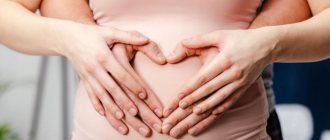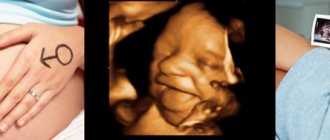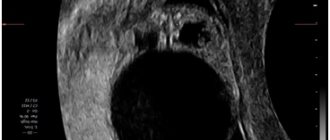Causes of constipation during pregnancy
Normal pregnancy
Fecal retention is a problem faced by two thirds of pregnant women. In the early stages, constipation is usually caused by hormonal changes and a change in the usual diet. In the second half of pregnancy, difficulty in defecation is often associated with mechanical compression of the intestines by the enlarged uterus and decreased physical activity. Fecal retention in such situations is not a cause for concern and is easily corrected using non-drug methods. The causes of constipation during the physiological course of gestation are:
- Increase in the size of the uterus
. In the second and third trimesters, the uterus quickly increases in size and compresses the intestinal loops, especially the cecum and sigmoid colon. This disrupts the normal passage of feces, increases water resorption with the formation of solid feces, which are difficult to excrete during emptying. Constipation with an enlarged uterus is accompanied by shortness of breath due to limited mobility of the diaphragm. - Hormonal changes
. In pregnant women, progesterone effects predominate. This hormone is critically necessary for maintaining pregnancy, since it reduces the contractile activity of all smooth muscle organs - the uterus, intestines, and bladder. Inhibition of peristaltic contractions leads to prolonged stagnation of feces in the intestines, chronic stool retention, and discomfort in the left abdomen during defecation. - Changes in eating habits
. A pregnant woman's diet can change significantly. Often, appetite increases in combination with a change in taste preferences. Constipation and other dyspeptic disorders can be caused by constant overeating, which significantly increases the load on the digestive system. In addition to fecal retention, there is discomfort and heaviness in the stomach after eating. - Physical inactivity.
Regular physical activity and preserved abdominal muscle tone are very important for the normal functioning of the gastrointestinal tract. Women in late gestation are prone to physical inactivity, as it becomes more difficult for them to perform usual activities. As a result, the motility of the colon slows down, stool is absent for several days, and the pregnant woman complains of other dyspeptic disorders. - Taking microelements
. To improve hematopoietic processes and prevent disorders of the skeletal system, pregnant women are prescribed dietary supplements with iron and calcium. The drugs can inhibit the motility of the digestive tract, so their side effects are constipation. When taking medications with iron, stool retention is combined with a change in the color of the stool - due to the presence of metal salts, its color turns black. - Emotional factors
. Constipation during pregnancy can be potentiated by neuropsychological changes. Hormonal changes and fear of impending childbirth often cause emotional lability and chronic stress. When the autonomic nervous system is involved in the process, sympathetic fibers are activated with inhibition of intestinal motility and constipation.
Pathology of pregnancy
Various disturbances of normal gestation provoke disorders of the digestive system, which may be associated both with the direct involvement of the gastrointestinal tract in early toxicosis, and with neuro-reflex mechanisms of stool retention. Constipation is often combined with other symptoms of dyspepsia - nausea, repeated vomiting, lack of appetite. If a symptom appears constantly, to determine further obstetric tactics it is necessary to clarify its causes. Most often, constipation during pregnancy occurs due to the following pathological conditions:
- Toxicosis
. Early toxicosis occurs in approximately 50-60% of pregnant women, but in only 10% they are characterized by a moderate or severe course. The main symptoms are various dyspeptic disorders; constipation often develops secondary to severe dehydration of the body due to repeated vomiting and intense salivation. The situation is aggravated by a decrease in food intake, which provokes a sharp weight loss. - Hypertonicity of the uterus
. The absence of defecation with increased tone of the smooth muscle fibers of the uterine wall usually has a psychogenic origin. Abnormal bowel movements are caused by conscious restriction of food intake and suppression of the urge to defecate, since pregnant women are afraid of the threat of miscarriage if they strain intensely while visiting the toilet. This condition, combined with physiological prerequisites, leads to chronic constipation. - Preeclampsia
. Slowing of intestinal motility during gestosis in the second half of pregnancy is caused by long-term use of sedatives, diuretics, antihypertensives and other drugs that are used to relieve negative symptoms. Constipation is also observed in severe cases of the disease, when pregnant women are transferred to parenteral nutrition and are provided with strict bed rest.
Retention of stool immediately after childbirth is usually observed in the presence of complications (perineal ruptures, perineotomy) or during birth by cesarean section. In such situations, the norm is the absence of bowel movements for up to 2 days; in the future, the use of laxatives is recommended. Timely restoration of peristalsis and defecation ensure a normal rate of uterine contraction.
Intestinal diseases
Sometimes constipation is not directly related to pregnancy and occurs due to functional or organic diseases of the digestive tract. Fecal retention is often provoked by morphological changes in the structure of the large intestine, which slows down the passage of feces and affects their consistency. Difficulty with defecation can be caused by dysregulation of the autonomic nerve ganglia, which provide peristaltic contractions of smooth muscles. Constipation during pregnancy is caused by concomitant diseases such as:
- Irritable bowel syndrome
. IBS is a functional disorder that is caused by impaired innervation of the intestinal wall, unbalanced diet, and emotional turmoil. The disease is typically characterized by a combination of constipation with a false urge to defecate, pain and discomfort in the left iliac region, and decreased appetite. The clinical picture is characterized by polymorphism and variability of symptoms. - Dysbacteriosis
. Specific hormonal changes during pregnancy sometimes disrupt the normal digestion of food ingredients, causing mild malabsorption and maldigestion. Constipation due to dysbacteriosis is accompanied by bloating, belching of air or rotten air. With significant maldigestion, there is a change in the color and consistency of stool, discomfort and nagging pain along the intestines. - Dolichocolon
. An increase in the length and diameter of individual sections of the intestinal tract (usually the colon and sigmoid colon) is combined with severe dyspeptic disorders. Women complain of prolonged constipation, severe flatulence, abdominal colic and spasms of various locations. Additional compression of the intestinal loops by the growing uterus during pregnancy leads to aggravation of symptoms and the appearance of signs of intoxication. - Haemorrhoids
. An increase in the concentration of progesterone and the mechanical pressure of an enlarged uterus reduces the tone of the venous plexuses of the hemorrhoidal zone. In this case, constipation during pregnancy is a consequence of consciously suppressing the urge to have a bowel movement, since the act of defecation causes severe pain. As the disease progresses, stool retention becomes chronic and persists even after treatment of hemorrhoids. - Biliary dyskinesia
. The effect of increased amounts of estrogen and progesterone often disrupts the functioning of the biliary system. A decrease in bile secretion due to hypomotor dyskinesia provokes the development of spastic constipation, which is characterized by difficult excretion of hard, fragmented feces (“sheep” feces). Typical is the appearance of nagging pain in the right hypochondrium. - Inflammatory bowel diseases
. Pregnancy in rare cases aggravates the course of chronic diseases such as ulcerative colitis and Crohn's disease. In these pathologies, the cause of fecal retention is organic damage to the mucous membrane and intramural autonomic plexuses. Constipation is combined with tenesmus, abdominal pain, and discharge of mucus streaked with blood from the rectum.
Physiological reasons
Physiological pain varies depending on the stage of pregnancy.
First trimester
At the beginning of pregnancy, the uterus stretches and shifts, and nearby tissues soften. As a result, pulling or stabbing pain appears in the lower abdomen, reminiscent of menstrual pain. Pain can also be caused by hormonal changes occurring in the body.
Second trimester
During this period, pressure on the pelvic bones and ligaments increases, which is accompanied by sharp short-term pain during physical activity, changing position, coughing, sneezing. Some women experience pain when the fetus moves.
Third trimester
Increased fetal growth provokes intense stretching of the uterine walls. In this case, the organ puts pressure on the intestines, disrupting digestion. As a result, dull pain, tingling, distension in the left side of the abdomen, constipation, flatulence, and dysbiosis are disturbing. At the end of the second trimester, training contractions are possible, manifested by rapid stretching in the lower abdomen.
Survey
Since stool retention is often caused by the physiological characteristics of pregnancy or painful conditions associated with gestation, a gastroenterologist examines women with complaints of constipation during pregnancy, subject to constant monitoring and consultations with an obstetrician-gynecologist. A study of the state of the digestive system is always carried out in conjunction with a standard gynecological examination of a pregnant woman.
The diagnostic search should first of all be aimed at excluding natural and pathological causes associated with bearing a child. The woman undergoes a comprehensive examination using only those methods that do not harm the fetus’s body. The most valuable for clarifying the root cause of fecal retention in pregnant women are:
- Ultrasonography
. Ultrasound is the main diagnostic method used during pregnancy, since it is absolutely harmless to the body of the mother and child. Sonography allows you to visualize intestinal loops, detect nonspecific signs of inflammatory processes or distension of a section of the intestine. In the third trimester, the diagnostic value of the method decreases, which is due to a significant increase in the uterus. - Stool analysis
. Standard macroscopic and microscopic analysis of stool makes it possible to suspect the presence of pathologies of both the small and large intestines, which often lead to constipation. To exclude dysbacteriosis, a bacteriological analysis of stool is performed. If organic lesions of the rectum or other parts of the colon are suspected, the Gregersen test for occult blood in the stool is performed. - Sigmoidoscopy
. The method of visual examination of the surface of the rectal mucosa is used to identify enlarged hemorrhoids and cracks, which are often found in pregnant women. In the first trimester, examination using a sigmoidoscope can be supplemented with sigmoidoscopy; in later stages, this manipulation is undesirable due to the risk of impact on the uterus. - Biochemical blood test
. Laboratory tests help to exclude pathologies of the gastrointestinal tract and biliary system. During pregnancy, a standard biochemical analysis is prescribed to measure the level of total protein, free and bound bilirubin, cholesterol, and glucose. According to indications, the concentrations of sex hormones in the blood are determined, the increase of which delays stool during gestation.
In most cases, constipation is eliminated after adjusting the diet.
The importance of microflora during pregnancy
The importance of microflora will help you understand the facts: the number of microorganisms that are in symbiosis with humans is several times greater than the number of cells of the body itself. Moreover, in the large intestine there are 2 times more of them than the cells of the whole body; they can cover two tennis cords. The microflora of the gastrointestinal tract of an adult weighs 2.5 - 3 kg or 5% of body weight.
Normal flora attaches (adhesion) to the outer membrane of the mucosal epithelium. Using the substances (mucin) of colonocytes in the intestine, it forms a protective biofilm of microcolonies (lacto- and bifidobacteria) covered with a “ placenta” . For a holistic, powerful biofilm, according to scientific research, 1 cm2 of the gastrointestinal mucosa should contain up to 500,000 beneficial bacteria. The creation of a biofilm - a “placenta” - allows beneficial bacteria to perform their vital functions for humans and carry out parietal digestion. Metabolism is normalized , substances for the construction of cells and tissues - vitamins, microelements, proteins, fats, carbohydrates - enter the blood and lymph.
Normal intestinal microflora is capable of producing factors that protect mucous membranes and tissues from pathogens: organic acids - SCFA - lactic, acetic, butyric, propionic, formic; lysozyme, bacteriocins, highly active hydrogen peroxide, substances with antibiotic-like properties that prevent the growth and reproduction of harmful bacteria, putrefactive, fermentative, gas-forming microflora.
The beneficial intestinal microflora is a “natural biosorbent” - absorbing, destroying (catabolism), removing poisons and toxins of microbial, animal or plant origin. In the processes of hepatic-intestinal recycling of various compounds, normal flora breaks down toxic carbon- and nitrogen-containing compounds, metabolizes urea by 50%, and inactivates histamine (allergies). With a lack of beneficial bacteria, this is an additional burden on the liver.
The immunomodulatory effect of intestinal microflora is aimed at stabilizing local and general immune reactions. Normoflora is involved in training immune cells to identify foreign, allergenic particles, in the differentiation of T-B lymphocytes, and in preventing the development of atopy (autoimmune processes). Under the influence of microflora, the phagocytic activity of macrophages, monocytes, the synthesis of interferon, Ig, and locally, the synthesis of secretory immunoglobulin Ig A increases.
A pregnant woman needs the healthy condition of all mucous membranes: the oral cavity, intestines, the entire gastrointestinal tract and the genitourinary system. Because the growth of pathogenic bacteria and the decrease of beneficial bacteria on any mucous membrane will certainly lead to a change in the composition of the intestinal microflora, to dysbacteriosis and digestive, metabolic, and immune disorders. If a pregnant woman has insufficient amounts of beneficial lactobifidobacteria in her intestines, the formation of biofilm and parietal digestion are disrupted, which means the entry into the blood of vital metabolic substances for the fetus. From the first weeks after conception, the fetus needs a sufficient amount of proteins, microelements, carbohydrates, vitamins for the active construction of cells and tissues.
Only in the presence of a sufficient number of bifidobacteria do they synthesize and accumulate (accumulate) vitamins B (1,2,5,6,9,12), K, C, PP, H, etc., and enter the bloodstream of microelements - calcium, iron , manganese, magnesium, potassium, zinc, selenium, copper, vitamin D. And lactobacilli normally secrete substances with powerful antimicrobial, antiseptic, anti-inflammatory effects, creating an environment on the mucous membrane of the vagina, intestines, oral cavity, and skin in which harmful bacteria die and are eliminated.
The composition of the intestinal microflora of the expectant mother can be disrupted by frequent colds, ARVI, stress, physical, psycho-emotional overload, taking chemical medications - antibiotics, hormonal drugs, contraceptives, drugs and other potent drugs. If a woman often uses douching, especially with chlorine-containing products, spermicides, vaginal contraceptives, and does not treat previously identified gynecological diseases, all this will lead to a decrease in lactobacilli, a change in the environment on the vaginal mucosa and the growth of pathogenic bacteria. The lactic acid, hydrogen peroxide and acidic environment secreted by vaginal lactobacilli stop the growth of opportunistic anaerobic bacteria, gardnerella, mobiluncus, staphylococci, E. coli, streptococci, and fungi - candida.
During pregnancy planning, future parents should pay special attention to the treatment of previously identified sexually transmitted infections: ureaplasma, chlamydia, gonococcus, mycoplasma, etc. Because these pathogens can “hide” in tissues, release toxins, and become more active when immunity decreases. But their presence in the body necessarily leads to a decrease in lactobacilli on the vaginal mucosa, genitourinary system and the growth of opportunistic bacteria.
The presence of changes in the composition of the intestinal microflora can be determined by analyzing a bacterial study of stool or studying the composition of SCFA in stool or by analyzing media for the level of microflora waste products, anaerobic index.
Symptomatic therapy
In 95% of cases, constipation during pregnancy is associated with physiological changes in the patient’s body; they are usually eliminated by adjusting the diet and increasing physical activity. To normalize peristalsis, it is recommended to eat food frequently and in small portions, avoiding feelings of hunger and excessive overeating. In order to increase the volume of stool and improve the passage of stool through the intestines, it is necessary to include foods rich in fiber in the diet - fresh vegetables and fruits, whole grain bread.
Women are advised to perform feasible physical exercises, specially selected taking into account the duration of pregnancy, stimulating the smooth muscles and facilitating bowel movements. For constipation caused by nervous overstrain, psychotherapy methods help well. The use of herbal or synthetic laxatives without a doctor’s prescription is prohibited, since the drugs can harm the child’s body or cause increased uterine tone.
After childbirth
If a child is put to the breast for the first half hour after birth and then receives natural feeding, then normal intestinal microflora is formed. Breast milk contains prebiotic substances: bifidus factor, secretory IgA, lymphocytes, macrophages, lactoferrin, beta-lactose, lysozyme, which block the colonization and growth of opportunistic bacteria. In the baby’s intestines, if conditions are favorable, bifidobacteria (B. bifidum, B. infantis, B. breve) multiply. A child receiving artificial formulas has a more diverse microflora in composition, with more bifidobacteria B. longum and lactobacilli.
The microflora stabilization phase ends by the 20th day of a newborn’s life, when bifido-lactoflora predominates in the intestinal microflora. Against the background of changes in nutrition, various dyspeptic disorders may appear, since clostridia often exceed permissible levels, bacteroides and veillonella, anaerobic cocci appear. In the first six months of a baby’s life, the future composition of the normal intestinal flora is formed. Therefore, even minor changes in the child’s health can lead to disruption of the gastrointestinal tract and can cause serious, poorly recoverable disturbances in the composition of the microflora. By 12 months, the intestinal microflora of breastfed or bottle-fed babies approaches the composition of the microflora of an adult.
Thus, there is never too much good microflora, given its diverse, beneficial properties, which are vital for the expectant mother and baby.
Taking live active lacto- and bifidobacteria with their beneficial waste products, for example, biocomplexes Normoflorins L, B and D , will help preserve your own beneficial microorganisms and improve digestion, metabolism, immunity of mother and baby.
Back to list Previous article Next article
The fetoplacental system is like a new endocrine gland
After implantation of the zygote in the uterine cavity, a new endocrine gland begins to form in the woman’s body - the placenta (baby place).
The placenta has two parts: fetal and maternal, the blood circulation of which never mixes. These parts of the placenta are as close as possible, which allows for the exchange of substances between the body of the mother and the fetus, i.e., in essence, allows the child to “eat, write and breathe,” and, therefore, grow and develop.
Metabolism between the mother and fetus is the main factor for its development. The exchange is carried out due to the permeability of the placenta, which is disrupted in most acute and chronic complications during pregnancy. Violation of the integrity of parts of the placenta and deterioration of its permeability leads to fetal death and termination of pregnancy.
The death of the fetus and termination of pregnancy is also possible for another reason, when the mother’s body suddenly decides that the fetus is a foreign protein for it. But this is actually true. However, nature has provided a protective mechanism that does not allow the mother's immune system to recognize antigens of paternal origin embedded in the child.
This protective mechanism consists of certain factors that block the mother’s immune system and provide local immunological comfort. With spontaneous abortions, blocking factors in the mother's blood are reduced or absent.
The placenta produces a wide range of hormones and specific proteins that enter the mother's blood and amniotic fluid. They regulate the normal course of pregnancy and fetal development by changing the function of other endocrine glands and life support organs in general.
By the level of hormones and specific proteins of the placenta, determined in the mother’s blood, in the fetal blood or in the amniotic fluid, the condition of the fetus and the function of the placenta can be assessed, which is what obstetric endocrinology deals with. Thus, studying the endocrine function of the fetoplacental complex can significantly improve the diagnosis of the fetal condition at different stages of pregnancy.
The appearance of a new endocrine gland leads to other changes in the female body.
The appearance of a woman changes. Appears:
- pigmentation of the skin (forehead, cheeks, chin, upper lip, white line of the abdomen, nipples and parapapillary zones), which is associated with significant stimulation of pigment formation by skin cells. The formation of pigment depends on the melanoform hormone of the adrenal gland, increased production of which occurs during pregnancy;
- low-grade body temperature is noted , which can last up to 16-20 weeks of pregnancy and is associated with hormonal fluctuations.
From the moment the placenta begins to produce progesterone, the temperature decreases and returns to normal.
- There is engorgement and soreness of the mammary gland due to an increase in its volume as a result of the proliferation of glandular tissue, enlargement of the nipples and protrusion of the areolar glands. In the second half of pregnancy, colostrum may be released;
- violation of facial proportions (enlargement of the nose, lips, chin, thyroid gland, especially in the second half of pregnancy), some enlargement of the limbs;
- stretching of the tissues of the anterior abdominal wall , mammary gland, thighs and the appearance of striae (“pregnant stripes”) in these areas (stria gravidarum). Their occurrence is associated with excessive stretching of the abdominal wall; this is more often observed in persons with a large abdominal volume (large fetus, polyhydramnios, multiple pregnancy) or with some lack of elastic fibers in the skin;
- varicose veins worsen or appear for the first time , especially in the lower extremities;
- The “proud posture and gait” of a pregnant woman is caused by a shift in the center of gravity of the body , increased mobility of the pelvic joints and limited mobility of the hip joints.
- Progressive increase in body weight , which is caused both by the growth of the fetus and uterus, and by the characteristics of metabolic processes and fluid retention in tissues. The average weight gain during pregnancy is 10-12 kg, of which 5-6 kg is due to the fertilized egg (fetus, placenta, amniotic fluid), 1.5-2 kg for enlarged uterus and mammary glands, 3-3.5 kg - to directly increase a woman’s body weight.
Before childbirth (3-4 days), a pregnant woman’s body weight drops by 1.0-1.5 kg, due to the peculiarities of metabolic processes.
What affects the intestines and microflora of expectant mothers?
Bacteria living in the human body (and there are more than three hundred species) are divided into beneficial and opportunistic. Beneficial microflora include, first of all, bifidobacteria and lactobacilli, as well as E. coli, with the participation of which many vitamins are synthesized. In addition, they favor the functioning of the intestinal tract, improve the functioning of the nervous system, and regulate the absorption function of the intestine.
With the onset of pregnancy, the expectant mother’s intestines function with some peculiarities that arise due to the fact that:
- the growing fetus begins to put pressure on the intestines and blood circulation in the pelvic vessels may be disrupted;
- hormonal changes in the body, which promote relaxation of the uterus, also reduce intestinal motility. In addition, intestinal motor function (peristalsis) is also reduced due to pregnant women taking antispasmodic and sedatives, which are often prescribed to them in the clinic.
Despite the fact that the synthesis of substances that stimulate the intestines is provided by Mother Nature, and it does not stop during gestation, the ability of a pregnant woman’s body to respond to them is significantly reduced. Let’s add to what has been said the tendency of expectant mothers to stress and anxiety, and the picture will be complete. Or rather, almost complete. Because there are two more significant factors: poor nutrition and uncontrolled use of medications, especially antibiotics.
As a result, pregnancy is complicated by the occurrence (or exacerbation) of the following diseases and conditions: hemorrhoids - a disease directly related to inflammation of the hemorrhoidal veins, their thrombosis, as well as tortuosity, which contributes to the formation of nodes around the rectum; constipation – periodically occurring difficulties with bowel movements (slow or completely insufficient bowel movements); intestinal dysbiosis - an imbalance of beneficial and opportunistic microflora in favor of the latter, that is, its qualitative and quantitative composition and ratio.








